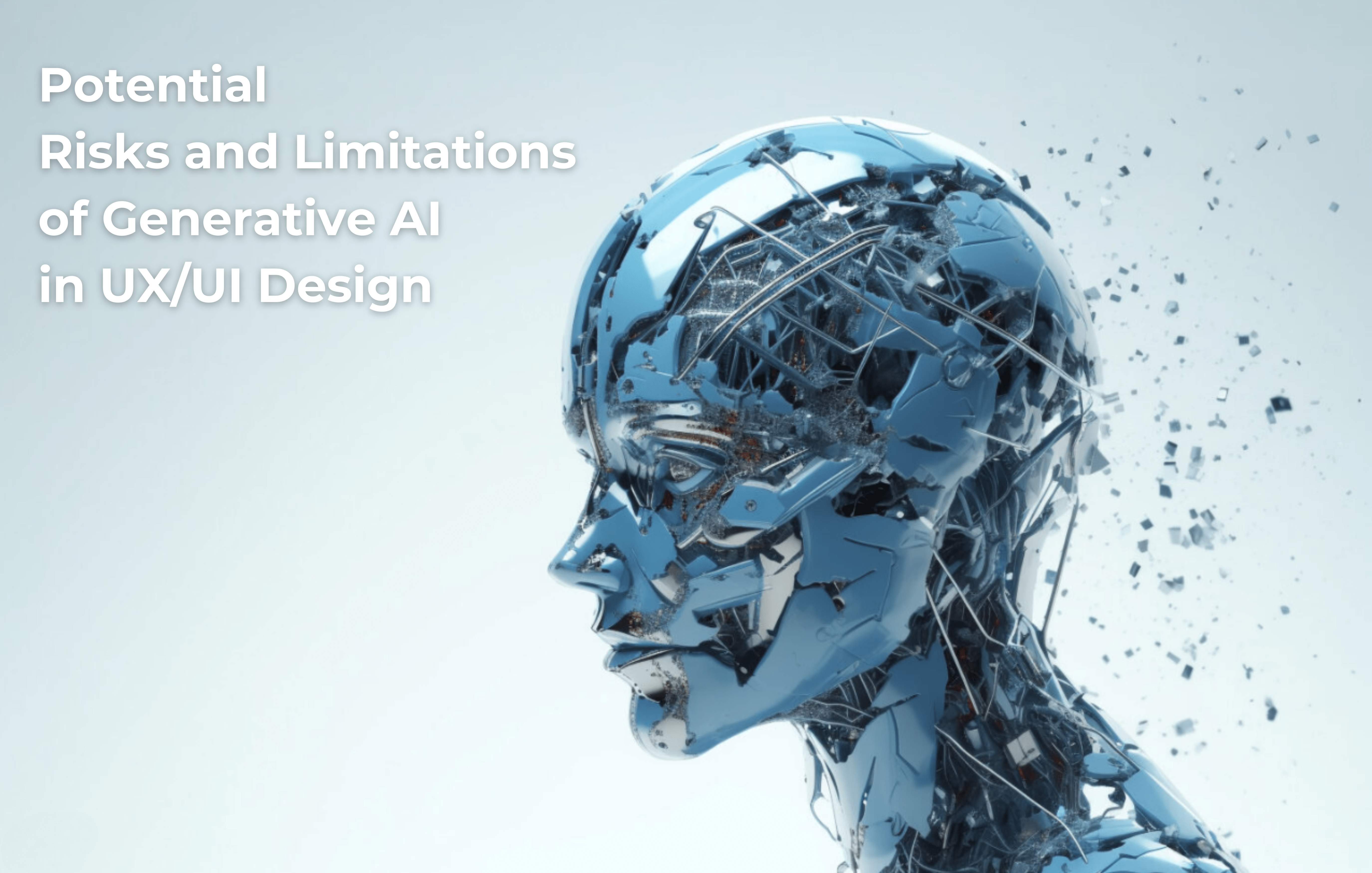There’s no doubt that artificial intelligence (AI) has been making a significant impact on many aspects of our lives. In the world of design, the use of AI is becoming increasingly prevalent, with generative AI being one of the most exciting developments in recent years. While there are still many people who may have mixed feelings about AI in general, there is an undeniable impact it has made in the field of UI/UX design.
In this article, we will explore the impact of generative AI on UX/UI design. We’ll discuss what generative AI is, how it is being used in UX/UI design, powerful AI tools on UX/UI design and the potential risks and benefits of using it. Finally, we’ll discuss how designers can strike a balance between human input and generative AI in UX/UI design.

How Generative AI is Changing UX/UI Design
Generative artificial intelligence (AI) is a type of artificial intelligence technology that can be used to create new content, including audio, code, images, text, simulations, and videos. Generative AI has become a game-changer in UX/UI design by autonomously generating creative output. From wireframes to design mockups to user interfaces, it produces multiple design variants in a short span, which accelerates the process of ideation, prototyping, and testing. Impressively, it employs machine learning algorithms to comprehend what constitutes a good design by analysing vast data sets. This enables designers to focus on enhancing the overall user experience, whilst delegating repetitive tasks to generative AI. It's akin to having a smart assistant who takes care of the grunt work, freeing up designers to unleash their creativity!
Streamlined Design Processes
Generative AI can assist designers in streamlining their design processes, making it easier to create unique, attractive interfaces. By using generative AI to automate repetitive design tasks such as layout and composition, designers can shift their focus towards more creative tasks. Instead of spending countless hours manually iterating designs, generative AI can produce a wide range of designs based on user preferences, allowing designers to work more efficiently and focus on more critical creative tasks. It also enables better testing and prototyping, as designers and developers can experiment with multiple variations of a design and quickly assess which one works best to meet the project's goals.
Personalised User Experiences
Generative AI can also enhance users' experience by providing personalised interfaces that cater to their individual needs. By understanding user behaviour and preferences, it can generate interfaces that meet their requirements, making their experience seamless, engaging, and customised. AI can analyze user data and behavior, which can be used to create personalized design experiences that cater to the individual needs and preferences of each user. Personalisation is essential in UX/UI design, as it enhances the user's engagement and helps retain them for longer periods.
Better Accessibility
Accessibility is another critical aspect of UX/UI design that generative AI can help with. By analysing user behaviour and feedback, it can detect areas where users may be struggling, and generate interfaces that are better suited to specific needs. This can be particularly beneficial for users with disabilities or visual impairments, improving their ability to navigate and interact with the interface.
Enhanced Creativity
With generative AI, designers can explore outside of their creative comfort zones by experimenting with new designs and styles. AI can generate designs that they may not have considered otherwise, allowing for more creative freedom and new opportunities. Designers can use AI to generate prototype designs that can be improved and transformed into entirely new ideas.
Reducing Costs
Finally, using generative AI in the design process can also significantly reduce costs. With fewer manual iterations and testing sessions, the project can be completed more efficiently, saving time and resources. It can also help avoid redesigning information architecture since it can adapt to user needs and preferences. Generative AI can be used to reduce the work of preparing long writeups such as interview scripts, survey questions, sample content for the prototypes, tasks, scenarios, etc.

7 Powerful AI Tools in UX/UI Design
With a plethora of tools at their disposal, designers can leverage AI to automate routine tasks, generate innovative design solutions, and augment their creative capabilities.
-
OpenAI's ChatGPT tool serves as a potent brainstorming partner, offering innovative ideas and generating meaningful narratives. It’s like having a virtual team member who is brimming with creative insights.
-
Adobe Sensei, another powerful suite of AI tools, can automate repetitive tasks such as image tagging, fill content based on surrounding areas, and provide personalised recommendations, freeing up designers to focus on higher-level creative work.
-
Figma is redefining collaborative design with its AI-powered features. Auto-layout and smart selection are just a couple of examples that demonstrate how AI can streamline design tasks.
-
Sketch2Code from Microsoft ingeniously uses AI to transform hand-drawn sketches into functional HTML code, bridging the gap between design and development.
-
Chatfuel helps create intuitive and effective chatbots using natural language processing and sentiment analysis.
-
TensorFlow, an open-source machine learning platform, can be used to build features like image recognition and natural language processing.
-
Lobe makes it easier than ever to build custom machine learning models without writing a single line of code.
These tools represent just the tip of the AI iceberg in the world of UX/UI design. As new AI technologies emerge, designers should explore them playfully, yet critically, to harness their potential and transform the design landscape.

Potential Risks and Limitations of Generative AI in UX/UI Design
As with any technology, there are some potential risks and limitations that need to be considered when using generative AI in UX/UI design. One risk is that the algorithms used in generative AI may contain biases that can lead to unappealing or even discriminatory designs. Additionally, the output from generative AI may contain errors, leading to poor user experiences. It’s important to note that generative AI is still in its early stages and requires expertise in data science to work effectively.
Using generative AI in UX/UI design currently lacks the ability to fully represent the human thought process or replicate human creativity. A machine can only do what it has been programmed to do; it doesn’t possess an intuitive ability to create something on its own. Therefore, AI may lack the human touch that often distinguishes good design. This highlights the need for human oversight and intervention in the design process.
To mitigate these risks, designers can use a diverse set of data when training their AI models and regularly test their AI designs for any potential bias or error.

Balancing Human Input and Generative AI in UX/UI Design
While generative AI is a game-changer for UX/UI design, it should not be viewed as a replacement for human input. Successful design involves empathy, understanding the user, and creating an emotional connection - areas where humans excel. Emotional design goes beyond aesthetics and usability to create experiences that resonate deeply with users. This is something that machines cannot replicate.
Designers should consider generative AI as an additional tool in their arsenal, complementing their creative skills rather than replacing them. Some companies have already found a balance, like for example - Adobe. They incorporated generative AI into their Adobe XD tool, which allows designers to generate layout options automatically and make design changes more efficiently. However, the final design still requires human creativity and input to ensure that it aligns with the project's goals and meets users' needs.
To find the right balance, we must remember that generative AI cannot replace the value of human creativity and emotional intelligence. By working together, designers and generative AI can create experiences that are both functional and emotionally resonant for users.
Designing for the Future
Generative AI is revolutionising the field of UX/UI design. By automating repetitive and complex design tasks, designers can focus more on creative endeavors, leading to faster and more efficient design processes. It's important to recognise that generative AI is not a replacement for human designers, but a powerful tool that enriches their workflow. With careful integration and the right checks in place, generative AI can lead to personalisation, informed decision-making, and quicker realization of design visions.






